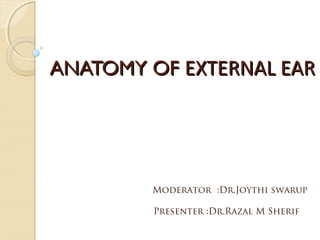
Anatomy of external ear
- 1. ANATOMY OFANATOMY OF EXTERNAL EAREXTERNAL EAR Presenter :Dr.Razal M Sherif Moderator :Dr.Joythi swarup
- 3. EXTERNAL EAREXTERNAL EAR AURICLE OR PINNA EXTERNAL AUDITORY CANAL
- 4. PINNAPINNA Single piece of yellow elastic cartilage covered with Perichondrium and skin(except lobule and outer part of external auditory canal) Attached to the side of skull by ligaments and muscles (supplied by facial nerve),muscles are not well developed in human
- 5. INCISURA TERMINALIS is a gap between the superior part of tragus and root of helix, which is devoid of cartilage having only fibrous tissue ◦ Endaural approach-inscion made on this area will not cut through the cartilage in surgery of EAC or Mastoid PINNAPINNAContd.Contd.
- 6. APPLIED ANATOMYAPPLIED ANATOMY Tragal cartilage, perichondrium from tragus, concha, fat from lobule – reconstruction surgery for middle ear Conchal cartilage – correct depressed nasal bridge Composite graft of skin & cartilage from pinna – repair the defects of nasal ala
- 7. NERVE SUPPLY - PINNANERVE SUPPLY - PINNA Greater auricular nerve ◦ most of the medial surface of pinna ◦ posterior part of lateral surface Lesser occipital ◦ upper part of medial surface Auriculo temporal ◦ tragus ◦ crus of helix ◦ adjacent part of helix
- 8. Auricular branch of vagus ◦ concha ◦ corresponding eminence on medial surface Facial nerve ◦ distributed with fibers of auricular branch of vagus ◦ concha ◦ retroauricular groove NERVE SUPPLY – PINNA Contd
- 10. EXTERNAL AUDITORY CANALEXTERNAL AUDITORY CANAL Extends from bottom of concha to tympanic membrane 24 mm (along post wall) not a straight tube outer part(cartilaginous) directed upwards, backwards & medially inner part (bony) directed downwards, forwards & medially pinna pulled upwards, backwards & laterally(make it straight)
- 11. EXTERNAL AUDITORY CANALEXTERNAL AUDITORY CANAL CARTILAGINOUS BONY
- 12. CARTILAGINOUS PARTCARTILAGINOUS PART Outer 1/3rd & 8mm canal Continuation of cartilage which forms the frame work of pinna ◦ Fissures of Santorini through them parotid or superficial mastoid infection can appear in the canal or vice versa
- 13. Skin covering the cartilaginous canal is thick and contains appendages like 1.CERUMINOUS GLANDS(modified sweat gland),which secrets cerumen (wax) 2.PILOSEBACEOUS GLANDS 3. HAIR is only confined to the outer canal & therefore furuncles are seen only in the outer 1/3rd of canal
- 14. BONY PARTBONY PART Inner 2/3rd & 16mm Skin lining the bony canal in thin & continuous over the tympanic membrane Devoid of skin appendages(Hair and ceremonious Glands About 6mm lateral to tympanic membrane , bony meatus presents as narrowing called ISTHMUS Foreign body lodged medial to isthmus, get impacted & are difficulty to remove
- 15. Anteroinferior part of deep meatus, beyond the isthmus, presents a recess - Anterior recess which acts as a cesspool for discharge & debris Antero inferior part of bony canal may present a deficiency in children up to age of 4 or sometimes in adults permitting infection to & from parotid (Foramen of Huschke)
- 16. NERVE SUPPLY - EACNERVE SUPPLY - EAC Auriculo temporal nerve(V3) ◦ anterior wall & roof Auricular branch of vagus (X) ◦ posterior wall & floor Posterior wall of auditory canal also receives sensory fibres of CN VII through auricular branch of vagus
- 17. TYMPANIC MEMBRANETYMPANIC MEMBRANE Forms partition between EAC & middle ear Obliquely set – 45deg with floor of EAC Posteriosuperior part more lateral than Anterioinferior part 9-10 mm tall 8-9 mm wide 0.1 mm thick
- 19. PARS TENSA PARS FLACCIDA (SHRAPNEL’S MEMBRANE) TYMPANIC MEMBRANETYMPANIC MEMBRANE
- 20. PARS TENSAPARS TENSA Forms most of Tympanic Membrane Periphery is thickened to form a fibro cartilaginous ring – ANNULUS TYMPANICUS, which fits in tympanic sulcus Central part of pars tensa is tented inwards at the level of tip of malleus – UMBO Bright Cone of Light – seen radiating from the tip of malleus to periphery in anterioinferior quadrant
- 21. PARS FLACIDAPARS FLACIDA Situated above lateral process of malleus between the notch of rivinus & anterior & posterior malleolar fold Appear slightly Pinkish
- 22. LAYERS OF TYMPANIC MEMBRANELAYERS OF TYMPANIC MEMBRANE Outer Epithelial layer ◦ continuous with skin lining the meatus Inner mucosal layer ◦ continuous with mucosa of middle ear Middle fibrous layer ◦ encloses the handle of malleus ◦ 3 types of fibres Radial Circular Parobolic ◦ Pars flacida – not organized(Fibrous Layers)
- 23. NERVE SUPPLY - TMNERVE SUPPLY - TM AURICULO TEMPORAL NERVE (V3) ◦ Anterior half of lateral surface AURICULAR BRANCH OF VAGUS (X) ◦ Posterior half of lateral surface TYMPANIC BRANCH OF CN IX (JACOBSON NERVE) ◦ Medial surface
- 24. ANATOMY OF EAR Video Presentation
Editor's Notes
- Thank you ;)
